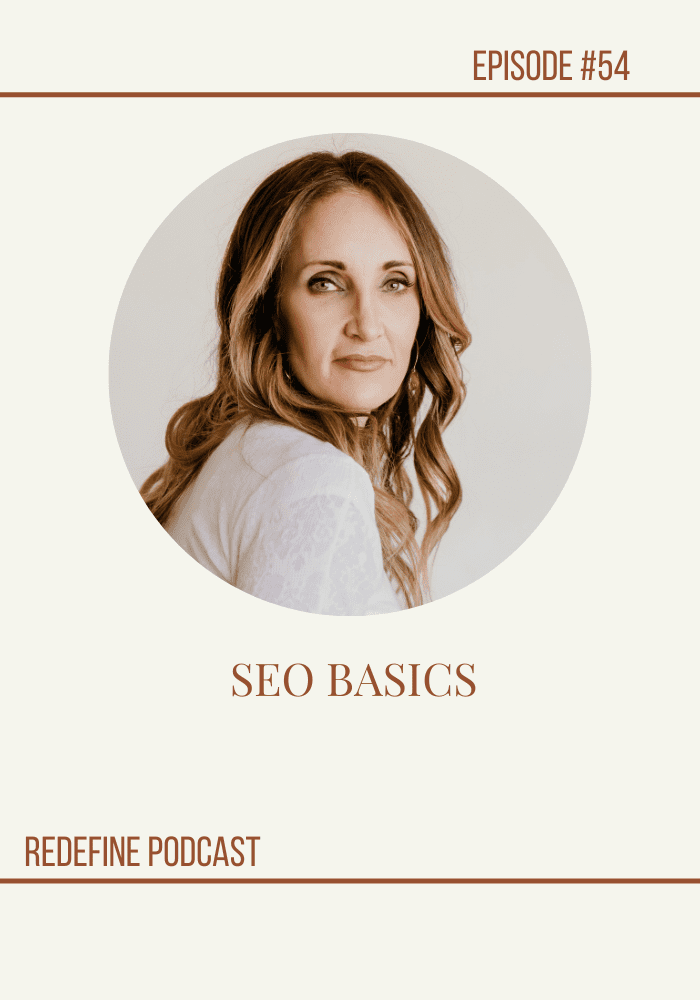
REDEFINE PODCAST
SEO Basics

One of the things I work on with my clients is SEO. SEO can be really intimidating for a lot of people, but it doesn’t have to be. I often tell my clients pick one or two things in your business and get really good at them. Take the time to learn these processes or systems and then be consistent.
SEO is one of those things entrepreneurs tend to ignore because it feels too complicated, but I promise you it is not. There are so many advantages to putting in the time with your own SEO. This can be done by first optimizing your website and second consistently putting out content within your niche.
SEO BASICS
The average person uses Google 4-5 times a day. Google dominates the search engine market. Research shows that there are 8.5 billion searches per day. It is the number one place people go when they are looking to solve a problem. If you are wondering where your ideal audience spends their time, chances are on Google.
I see a lot of entrepreneurs focusing all of their time to social media, which isn’t a bad thing. However, SEO has a way longer life span. This means that you create content on social media and it is buried within a few days and the chances of it being seen again is very slim, however you can write a blog post on a similar topic and will have a better chance of being seen again later.
What is SEO
If I haven’t convinced you to put some effort into improving your SEO, I will pressure you some more. 😉 I want you to understand SEO, that way it won’t be so overwhelming to you. I am going to try to break it down for you over a few different episodes so stay with me.
Let’s start with the basics. What is SEO? Search Engines Optimization, also known as SEO, is the process of affecting the visibility of your website or blog in a search engine’s unpaid results. In other words, when an individual does an internet search, a search engine will provide the best results. The highest-ranked result appears first and so on. The higher ranked results or pages translate to more traffic and more sales. It’s important to know what is SEO and how it works so you can leverage it in your business.
MArketing
Many people use SEO to help market their business. Because billions of people refer to Google first when looking for a service, product, or question, so SEO is an important marketing tool. The challenge with SEO is that search engines are in a constant state of change. SEO isn’t something you do once and never look at again. It is an ongoing process; because of this, consistency is a key factor.
Google often does algorithm updates. These tweaks can change the outcome of the search results. No one (except Google) knows the formulas that determine the results. Some people get frustrated with the unpredictability and decide it isn’t worth their time, however social media has similar unpredictable. Online marketing in general is ever-changing.
SEO Strategy
Many people reap great results from SEO and if you are an online business, I think it’s beneficial to have an SEO strategy. There are many things you can do that require minimal effort and will help you stand out from your competition.
You want to drive as much traffic as possible to your website. Understanding and learning how to implement SEO has lots of benefits. There are different types of SEO you should pay attention to. One type is On-Page SEO. This refers to the SEO on different pages of your website (home, about, work with, etc). There are elements you need to be aware of:
KEYWORDS
tools available to help you with your search. Once you have created your keyword list, implement those
keywords throughout your website descriptions, blog,
subheadings, url, etc.
TITLE TAG
I once thought I had to think up a clever title for any blog post I
wrote. I didn’t realize my clever titles were hindering my SEO
progress. Titles need to be straight forward and always contain
keywords. When determining a title, think of long–tailed
(descriptive sentences) keywords that your ideal client might type
into the search bar.
URL
In the settings sections of your website, there is a section called permalinks. Permalinks are the permanent URLs to your individual pages and blog posts. A permalink is the web address used to link to your content. You can set up your permalinks to be the title of your page or post. For example, I have titled this blog post “What is SEO and How Does it Work.” My WordPress website automatically generates the URL as www.brittnischroeder.com/what-is-seo-and-how-does-it-work. By creating this URL it will help improve my SEO.
META DESCRIPTION
The meta description is the brief description you see when search results appear. It is about 155 characters or a couple of sentences summarizing a page’s content followed by an ellipse (…). Search engines show the meta description in search results mostly when the searched-for phrase is within the description, so optimizing the meta description is crucial for on-page SEO.
SUBHEADINGS
A subheading is a subsection of your content. Subheadings help users and search engines to read and understand text. They act as main points for the readers and make it easier for people to understand what a post or page is about. Headings also define which parts of your content are important, and show how they’re interconnected. For example, I have used Title Tag, URL, Meta Description, etc. as subheadings in this post.
INTERNAL LINKS
Internal links are a type of hyperlink on a webpage to another page or resource within your website or domain. An essential part of SEO is keeping your reader on your website as long as possible. The longer a reader stays on your website the better your website will rank.
When you link different content, the goal is to direct your reader to more information within your site. For example, I might write an article on improving engagement on Instagram and link a reference to ideal clients to a blog post I wrote on the subject.
EXTERNAL LINKS
External links are similar to internal links. However, they direct you to other domains and link outside information that supports your content. The quality of the external link makes a difference. You want to add trustworthy and informative website links to help improve your credibility.
Whenever you link to another site, that site will see that you’re linking to them. Then, they are more likely to return the favor by linking to your site.
External links are a great way to reach out, make connections, and get your content seen. This is a great source of free traffic and will help improve your SEO. Linking to outside websites will not hurt your page rank as long as the link comes from legitimate sites. External links are more valuable if it links to popular and high-ranking sites that are related to your content.
IMAGE NAMES
The alt and title attributes of an image are commonly referred to as alt tag, alt text, or title tag. Image file names alert Google and other search engine crawlers as to the subject matter of the image. When readers are searching for content they may search for images and then be directed to your website. When it comes to SEO use creative descriptive, keyword-rich file names. Always use images and image names that are relevant to your content.
Search engine optimization can be a huge part of getting traffic to your blog or website. When you do it correctly and are consistent, you will see the results. There are helpful tools such as Yoast SEO plugin that help you implement these tools. Remember, like most things, it takes time! So be patient. If you implement these tools, you will start to see an increase in your traffic over time.







